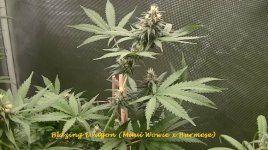Tan BD 2 month smpke report
Tan BD 2 month smpke report
My last bit of Tan BD bud......the longest cure so far.....a little over 2 months,...... I cant seem to let it sit.....my favorite smoke......after a couple months...Im tasting a powdered candy kind of fruity taste.....some citrus,.....fruity powdered candy taste.....vapor is full, thick, and spicy......not harsh....very smooth vapor......Im vaping right now.....this bud seems to give me the feeling of summer.....for some reason.......upbeat, bright, optimistic, creative feeling.....sooo smooth.......The buds were quite sticky after a couple months in the jars.....So sticky they felt wet......Make ya wanna lick ya fingers...-n- stuff.....
It smells like old skool weed. light funky....I think I can feel it in the head...and the body a bit.....I feel like a big ass church bell that just got rung...........that vibration.........yup.........me like it........
well....my vape session has ended, and I Dont Need Nooooooo Moooooooeeee!! Cuz I'm BLOWD!!!!
Tan BD 2 month smpke report
My last bit of Tan BD bud......the longest cure so far.....a little over 2 months,...... I cant seem to let it sit.....my favorite smoke......after a couple months...Im tasting a powdered candy kind of fruity taste.....some citrus,.....fruity powdered candy taste.....vapor is full, thick, and spicy......not harsh....very smooth vapor......Im vaping right now.....this bud seems to give me the feeling of summer.....for some reason.......upbeat, bright, optimistic, creative feeling.....sooo smooth.......The buds were quite sticky after a couple months in the jars.....So sticky they felt wet......Make ya wanna lick ya fingers...-n- stuff.....
It smells like old skool weed. light funky....I think I can feel it in the head...and the body a bit.....I feel like a big ass church bell that just got rung...........that vibration.........yup.........me like it........
well....my vape session has ended, and I Dont Need Nooooooo Moooooooeeee!! Cuz I'm BLOWD!!!!




